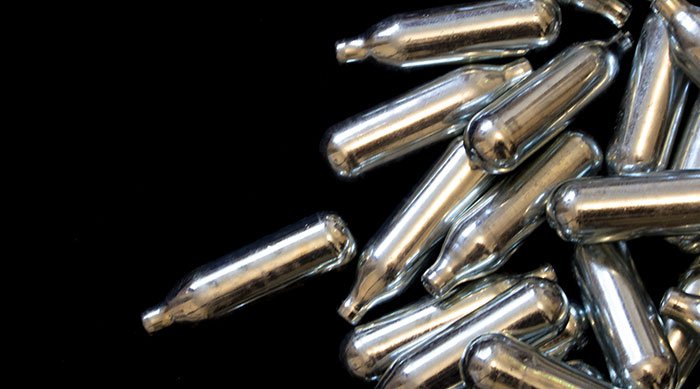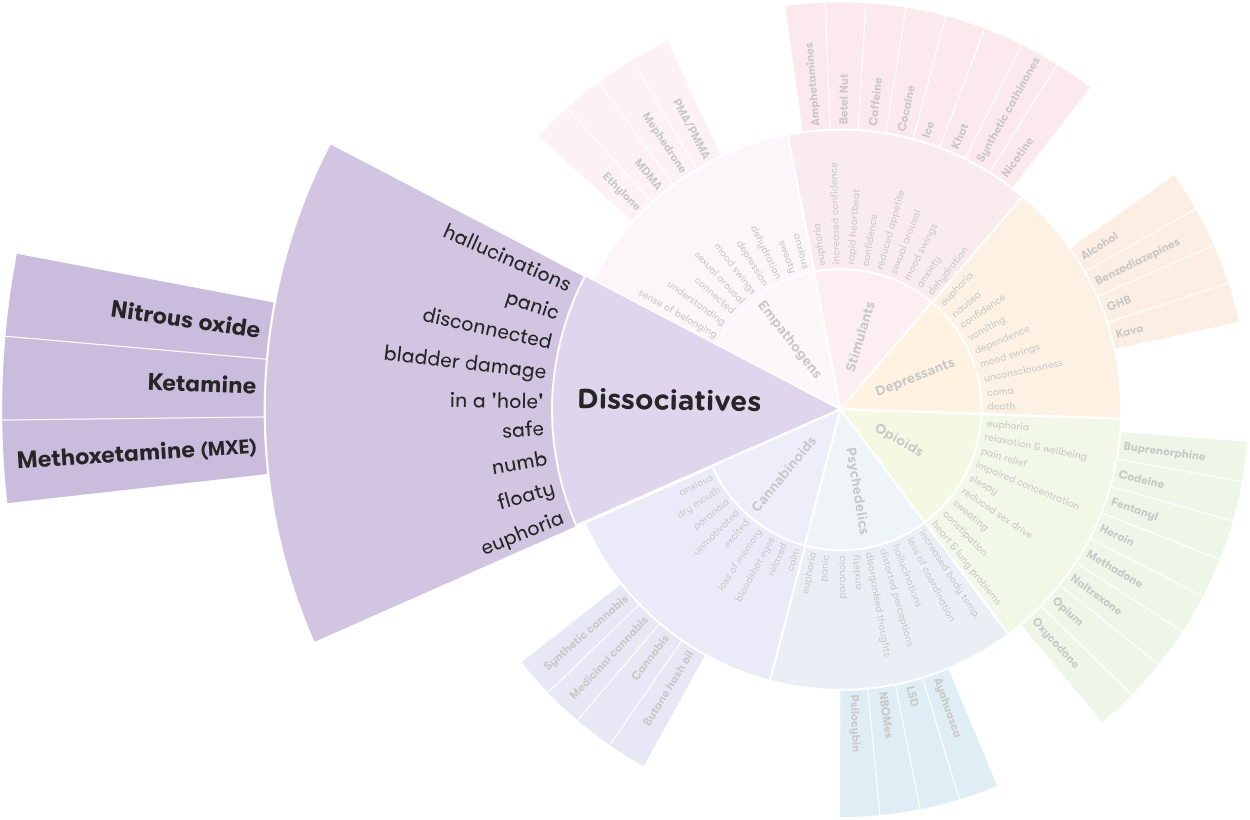How is it used?
The gas is inhaled, usually by releasing nitrous gas cartridges (bulbs or whippets) into another object, such as a balloon, or directly into the mouth.3 Effects are felt almost immediately and last for a few minutes.5
Effects of nitrous oxide
Use of any drug can have risks. It’s important to be careful when taking any type of drug..
Nitrous oxide affects everyone differently, based on:
- size, weight and health
- whether the person is used to taking it
- whether other drugs are taken around the same time
- the amount taken
- the environment (where the drug is taken)
The following effects may be felt almost immediately and can last for a few minutes:
- euphoria
- numbness of the body
- sedation
- giddiness
- uncontrolled laughter
- reduced co-ordination
- blurred vision
- confusion
- dizziness and/or light-headedness
- sweating
- feeling unusually tired or weak.5
If a large amount of nitrous oxide is inhaled, or the person has certain pre-existing health conditions, or doesn’t get enough oxygen, it can lead to:
- loss of blood pressure
- fainting
- heart attack.5
Inhaling nitrous oxide can be fatal if you don’t get enough oxygen, which is known as hypoxia.5
Impact of mood and environment
Drugs that affect a person’s mental state (psychoactive drugs) can also have varied effects depending on a person’s mood (often called the ‘set’) or the environment they are in (the ‘setting’):
- Set: a person’s state of mind, previous encounters with dissociative drugs, and expectations of what’s going to happen. For example, feelings of stress or anxiety before using nitrous oxide may result in an unpleasant experience and make those feelings worse.6
- Setting: the environment in which someone uses nitrous oxide – whether it’s known and familiar, who they’re with, if they’re indoors or outdoors, the type of music and light. For example, using nitrous oxide in a calm, quiet and relaxed environment can lead to, or contribute to, a pleasant experience but being in a noisy, crowded place may result in a negative experience.6
- Being in a good state of mind, with trusted friends and a safe environment before taking nitrous oxide reduces the risk of having a ‘bad’ trip.
Overdose
If you take a large amount of nitrous oxide, have pre-existing health conditions (such as epilepsy or heart disease), or don’t get enough oxygen when using nitrous oxide, you could overdose.5
Call an ambulance straight away by dialling triple zero (000) if you, or someone else, has any of the following symptoms:
- seizures
- irregular heartbeat, chest pain, or heart palpitations
- loss of consciousness
- shallow or slow breathing, or no breathing
- skin colour changes, especially lips and fingernails – typically bluish purple skin (for people with lighter complexions) or greyish or ashen skin (for people with darker complexions).5
Coming down
Nitrous oxide effects are felt almost immediately and can last for a few minutes. While most effects wear off quickly, you may experience ‘come down’ effects for 10-15 minutes after use, such as dizziness or a headache.5,7
Long-term effects
Regular use of nitrous oxide may eventually cause:
- memory loss
- vitamin B12 depletion (long-term depletion causes brain and nerve damage)
- ringing or buzzing in the ears
- incontinence
- numbness in the hands or feet
- limb spasms, or loss of muscle control in arms and legs
- potential birth defects (if consumed during pregnancy)
- weakened immune system
- disruption to reproductive systems.5,8
Nitrous oxide and mental health
Regular use of nitrous oxide may impact someone’s mental health, and lead to:
- depression
- psychological dependence
- psychosis.5
Tolerance and dependence
People who regularly use nitrous oxide can become dependent on the drug.5 They may feel they need nitrous oxide to go about their normal activities like working, studying and socialising, or just to get through the day. They may also develop a tolerance to it, which means they need to take larger amounts of nitrous oxide to get the same effect.5
Mixing nitrous oxide with other drugs
Mixing nitrous oxide with other drugs can have unpredictable effects and increase the risk of harm.
- Nitrous oxide and alcohol/ GHB/GBL/opioids/benzodiazepines: can increase risk of overdose and/or nausea, impaired coordination, memory loss, sleepiness and loss of consciousness.7
- Nitrous oxide and cannabis/ketamine /psychedelics: can briefly intensify their effects, and increase the likelihood of hallucinations.7
More on Polydrug use
Polydrug use is a term for the use of more than one drug or type of drug at the same time or one after another. Polydrug use can involve both illicit drugs and legal substances, such as alcohol and medications.
Reducing harm
Nitrous oxide gas is very cold (-40C degrees) and can cause frostbite to the nose, lips and throat (including vocal cords), if inhaled directly from bulbs or dispensers.7
Faulty gas dispensers can cause harm as they may explode. Dispensing several gas canisters consecutively with one cracker (a handheld device used to ‘crack’ a nitrous oxide bulb/whippet) or dispenser can also cause cold burns to the hands.10
There are ways in which you can reduce the risks associated with using nitrous oxide:
- avoid using alone, or in dangerous or isolated places · never put plastic bags over the head or block breathing in any way
- avoid using in enclosed spaces without ventilation
- warm the gas and normalise the pressure by releasing the nitrous into a balloon before inhaling, instead of inhaling directly from the bulb or dispenser, as this can cause frostbite
- avoid using near flammable substances, such as naked flames or cigarettes
- avoid drinking alcohol or taking other drugs at the same time
- avoid standing or dancing while inhaling, as you may pass out
- take breaks, give yourself some time to breathe in some fresh air when using nitrous oxide7
Withdrawal
There are no significant withdrawal symptoms apart from potential cravings to use more nitrous oxide.5
Getting help
If your use of nitrous oxide is affecting your health, family, relationships, work, school, financial or other life situations, or you’re concerned about someone, you can find help and support.
- Call the National Alcohol and Other Drug Hotline on 1800 250 015 for free and confidential advice, information and counselling about alcohol and other drugs
- Help and support services search Find a service in your local area from our list. Simply add your location or postcode and filter by service type to quickly discover help near you.
If you’re looking for other information or support options, send us an email at druginfo@adf.org.au
Path2Help
Not sure what you are looking for? Try our intuitive Path2Help tool and be matched with support information and services tailored to you.
Find out more
The sale of nitrous oxide for human consumption is a criminal offense, however laws on the supply of nitrous oxide vary by jurisdiction, and carrying nitrous oxide and paraphernalia may put you at risk of criminal charges.7
Find out more about nitrous oxide and the law via your state or territory:
National
The latest National Drug Strategy Household Survey reported that proportion of people who had ever used inhalants (including nitrous oxide) grew between 2019 (4.8%) and 2022–2023 (5.6%), however a similar number of people had used inhalants in the last 12 months.11 Nitrous oxide was among the two most common forms of inhalants used.11
In the 2023 National Ecstasy and Related Drugs Reporting System report, recent use of nitrous oxide among participants also remained stable between 2022 – 2023.12
- van Amsterdam JGC, Nabben T, van den Brink W, Lectoraat Coördinatie Grootstedelijke V. Increasing recreational nitrous oxide use: Should we worry? a narrative review 2022 [06.05.2024].
- Bahji A, Bach P, Danilewitz M, Crockford D, el-Guebaly N, Devoe DJ, et al. Comparative efficacy and safety of pharmacotherapies for alcohol withdrawal: a systematic review and network meta-analysis. Addiction [Internet]. 2022 [06.05.2024]; 117(10):[2591-601 pp.].
- Allan J, Cameron J, Bruno J. A Systematic Review of Recreational Nitrous Oxide Use: Implications for Policy, Service Delivery and Individuals. International journal of environmental research and public health [Internet]. 2022 [06.05.2024]; 19(18).
- Li L, & Vlisides, P. Ketamine: 50 Years of Modulating the Mind. Frontiers in Human Neuroscience [Internet]. 2016 [08.05.2024]; 10:[1-15 pp.].
- Xiang Y, Li L, Ma X, Li S, Xue Y, Yan P, et al. Recreational Nitrous Oxide Abuse: Prevalence, Neurotoxicity, and Treatment. Neurotoxicity Research : Neurodegeneration, Neuroregeneration, Neurotrophic Action, and Neuroprotection [Internet]. 2021 [06.05.2024]; 39(3):[975-85 pp.].
- Nutt D. Drugs without the hot air : making sense of legal and illegal drugs. Cambridge: UIT Cambridge Ltd; 2012. 7. Hi-Ground. Nitrous Oxide [[06.05.2024].
- van Amsterdam J, van den Brink W. Nitrous oxide-induced reproductive risks: Should recreational nitrous oxide users worry? Journal of psychopharmacology (Oxford, England) [Internet]. 2022 [06.05.2024]; 36(8):[951-5 pp.].
- Darke S, Lappin, J. & Farrell, M. The Clinician's Guide to Illicit Drugs. United Kingdom: Silverback Publishing 2019 [08.05.2024].
- Quax MLJ, Van Der Steenhoven TJ, Antonius Bronkhorst MWG, Emmink BL. Frostbite injury: an unknown risk when using nitrous oxide as a party drug. Acta Chirurgica Belgica [Internet]. 2022 [06.05.2024]; 122(2):[140-3 pp.].
- Australian Institute of Health and Welfare. National Drug Strategy Household Survey 2022–2023 2024 [12.06.2024].
- Sutherland R, Karlsson A, King C, Uporova J, Chandrasena U, Jones F, et al. Australian Drug Trends 2023: Key Findings from the National Ecstasy and Related Drugs Reporting System (EDRS) Interviews2023 [22.04.2024].

